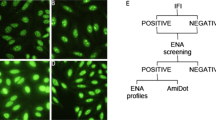Abstract
A retrospective multi-center data collection of clinical, laboratory, and treatment characteristics of 94 Caucasian children and adolescents with Raynaud’s phenomenon (RP) started at a mean age of 12.8 ± 5 years, with variable involvement of hands, feet, and face, was performed for a period of 3 years. Collected data included nailfold videocapillaroscopy (NVC), lung function tests, and different laboratory tests finalized to characterize an eventual connective tissue disease (CTD), disclosed by RP itself. Twelve patients presented an early-scleroderma pattern at NVC, 1 a late-scleroderma pattern, and 58 a nonspecific pattern. Laboratory data results showed the positivity of anti-nuclear antibodies (ANA) in 29 % of patients. After this 3-year period of observation, 8 patients had developed a CTD. Our data examined by multivariate analysis, though limited to a multi-center cohort of pediatric patients with RP, strongly suggest that ANA positivity is a significant predictor of progression of RP towards a CTD.
Similar content being viewed by others
References
Maverakis E, Patel F, Kronenberg DG et al (2014) International consensus criteria for the diagnosis of Raynaud’s phenomenon. J Autoimmun 48–49:60–65
LeRoy EC, Medsger TA Jr (1992) Raynaud’s phenomenon: a proposal for classification. Clin Exp Rheumatol 10:485–488
Jung LK, Dent PB (1983) Prognostic significance of Raynaud’s phenomenon in children. Clin Pediatr (Phila) 22:22–25
Gerbracht DD, Steen VD, Ziegler GL et al (1985) Evolution of primary Raynaud’s phenomenon (Raynaud’s disease) to connective tissue disease. Arthritis Rheum 28:87–92
Nigrovic PA, Fuhlbrigge RC, Sundel RP (2003) Raynaud’s phenomenon in children: a retrospective review of 123 patients. Pediatrics 111(4 Pt 1):715–721
Koné-Paut I, Olivar E, Elbhar C, Garnier JM, Berbis P (2002) Raynaud’s syndrome in children. Study of 23 cases. Arch Pediatr 9:365–370
Pavlov-Dolijanovic S, Damjanov NS, Stojanovic RM et al (2012) Scleroderma pattern of nailfold capillary changes as predictive value for the development of a connective tissue disease: a follow-up study of 3,029 patients with primary Raynaud’s phenomenon. Rheumatol Int 32:3039–3045
Avouac J, Fransen J, Walker UA et al (2011) Preliminary criteria for the very early diagnosis of systemic sclerosis: results of a Delphi Consensus Study from EULAR Scleroderma Trials and Research Group. Ann Rheum Dis 70:476–481
Conflict of interest
None.
Author information
Authors and Affiliations
Corresponding author
Additional information
Fernanda Falcini and Donato Rigante equally contributed to this brief report.
Rights and permissions
About this article
Cite this article
Falcini, F., Rigante, D., Candelli, M. et al. Anti-nuclear antibodies as predictor of outcome in a multi-center cohort of Italian children and adolescents with Raynaud’s phenomenon. Clin Rheumatol 34, 167–169 (2015). https://doi.org/10.1007/s10067-014-2833-6
Received:
Accepted:
Published:
Issue Date:
DOI: https://doi.org/10.1007/s10067-014-2833-6




